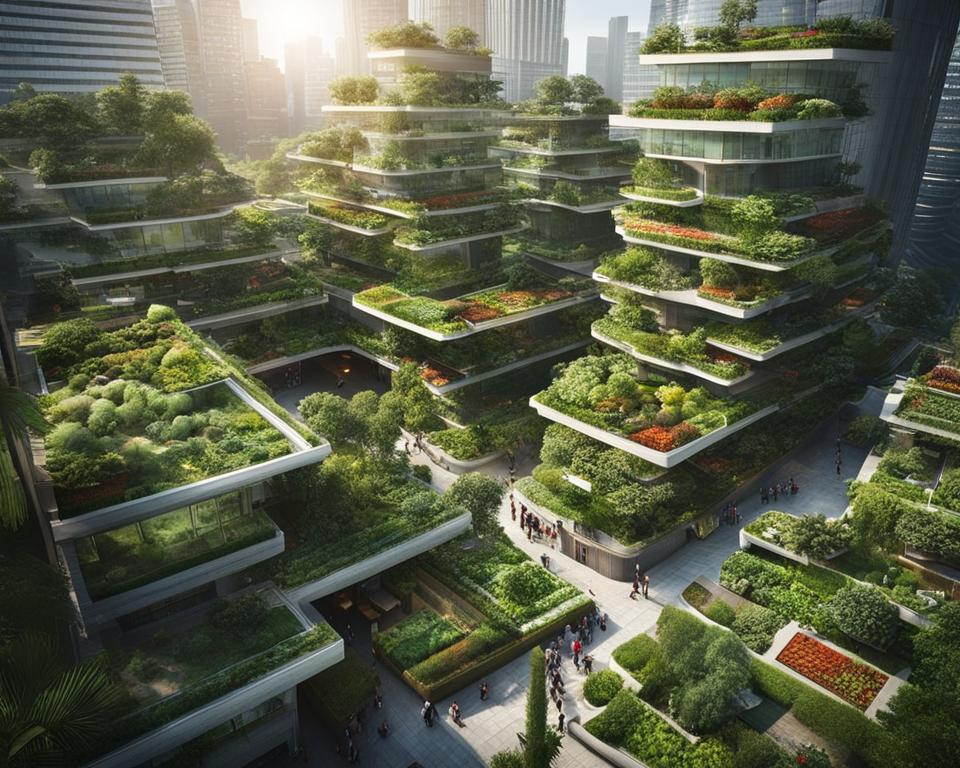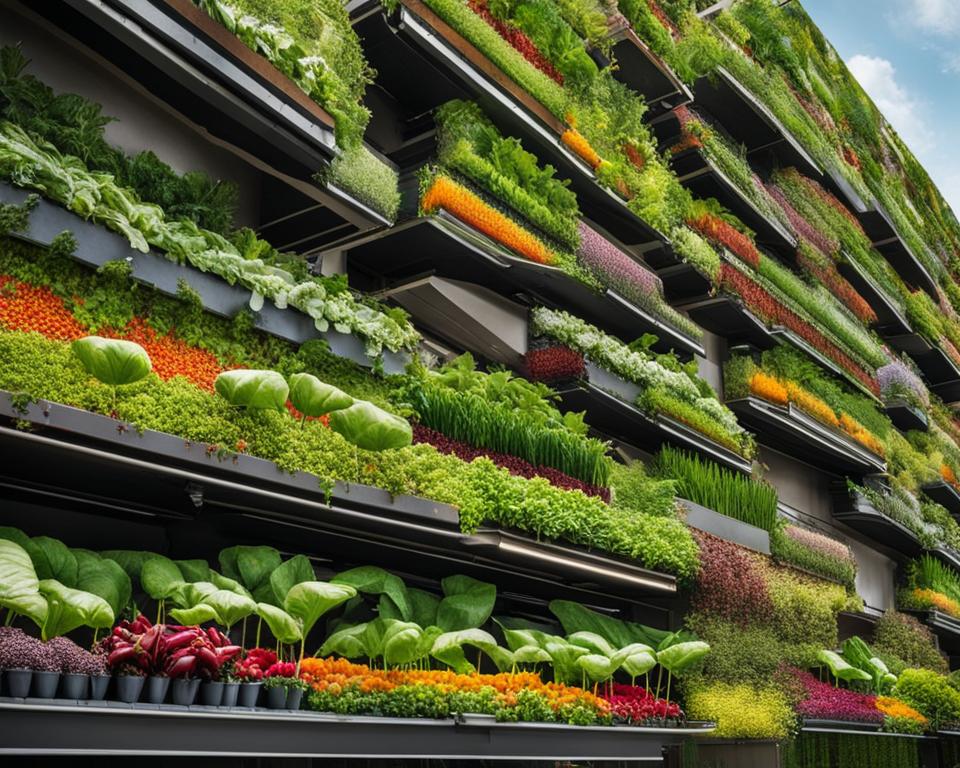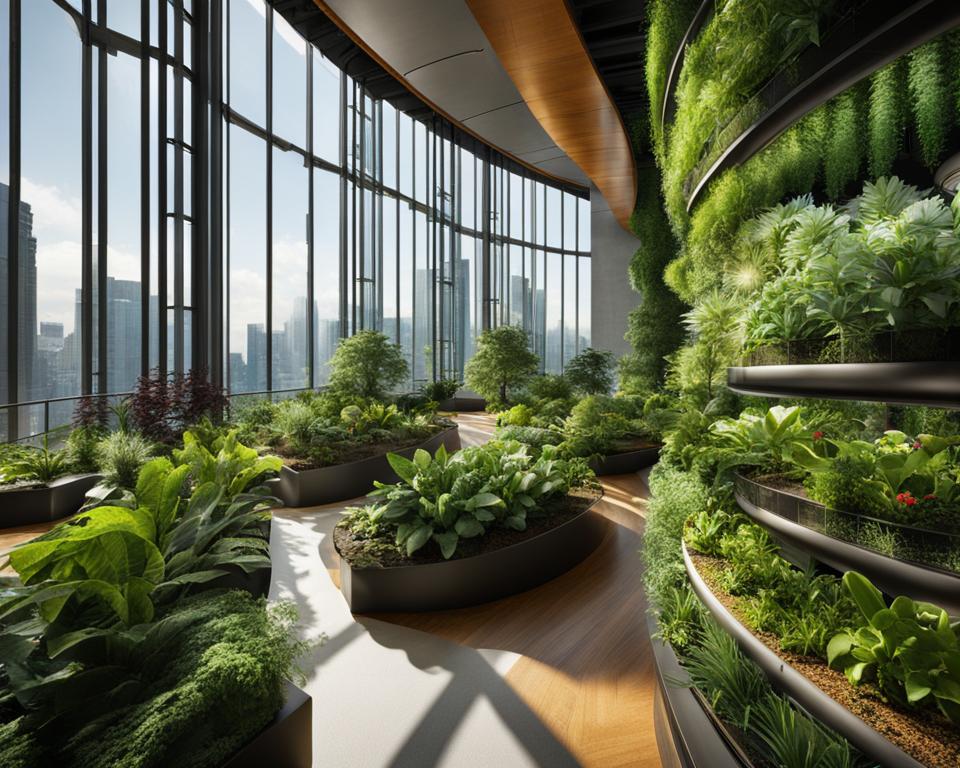Urban indoor and vertical gardening is revolutionizing the way we bring nature to urban environments. With vertical gardens, also known as living walls or green walls, plants can thrive on vertical surfaces, transforming office buildings, apartment complexes, and shopping centers into vibrant green spaces. These innovative installations not only add visual appeal but also offer a host of environmental benefits, making them a crucial part of our sustainable future.
Imagine strolling through city streets surrounded by lush greenery, enjoying improved air quality, and witnessing the beauty of diverse plant species. Urban indoor and vertical gardening is making this vision a reality, turning concrete jungles into sustainable oases.
Key Takeaways:
- Urban indoor and vertical gardening brings nature to urban environments.
- Vertical gardens offer visual appeal and contribute to improved air quality.
- These gardens provide a range of environmental benefits, including noise reduction and rainwater management.
- Successful projects worldwide showcase the potential of urban indoor and vertical gardening.
- Vertical gardens enhance biodiversity and create healthier indoor climates.
The Environmental Impacts of Vertical Gardening
Vertical gardening has significant positive environmental impacts. These gardens help improve air quality by absorbing pollutants like carbon dioxide and filtering particulate matter from the air. They also mitigate the urban heat island effect, reducing temperatures in cities by up to 37°C. Vertical gardens promote biodiversity by providing habitats for insects and birds and act as natural sound barriers, reducing noise pollution. Additionally, vertical gardens absorb rainwater, delaying its discharge into the sewage system. These gardens also contribute to a healthier indoor climate, reducing complaints such as irritated eyes, headaches, and tiredness.
Vertical gardening offers a sustainable solution to some of the environmental challenges faced in urban areas. As plants absorb carbon dioxide and release oxygen, vertical gardens help combat air pollution and improve overall air quality. By reducing the urban heat island effect, these gardens help lower temperatures in cities, creating a more comfortable and livable environment. The biodiversity supported by vertical gardens not only helps to balance ecosystems but also adds beauty and tranquility to urban spaces.
Furthermore, the ability of vertical gardens to absorb rainwater and delay its discharge into the sewage system helps prevent flooding and reduces the strain on drainage infrastructure. These gardens act as natural filters, removing pollutants and impurities from rainwater before it enters the sewage system. Additionally, the presence of plants in indoor spaces has been shown to have a positive impact on human health and well-being. Vertical gardens improve indoor air quality by reducing the concentration of volatile organic compounds and other harmful substances, resulting in a healthier and more pleasant indoor environment.
The Benefits of Vertical Gardening
“Vertical gardens promote biodiversity, improve air quality, reduce noise pollution, and contribute to a healthier indoor climate.”
- Improved air quality: Vertical gardens absorb pollutants and release oxygen, helping to reduce air pollution in urban areas.
- Reduced urban heat island effect: By shading buildings and green spaces, vertical gardens help lower temperatures, creating a more comfortable environment.
- Enhanced biodiversity: Vertical gardens provide habitats for birds and insects, supporting urban ecosystems.
- Noise reduction: The presence of plants in vertical gardens acts as a natural sound barrier, reducing noise pollution.
- Rainwater management: Vertical gardens absorb rainwater and delay its discharge into the sewage system, preventing flooding and reducing strain on drainage infrastructure.
- Improved indoor climate: Vertical gardens contribute to a healthier indoor environment by reducing the concentration of harmful substances and improving air quality.
Choosing the Right Plants for Vertical Gardens
When it comes to vertical gardening, selecting the right plants is crucial for a successful and thriving garden. The choice of plants will depend on various factors, including the climate and region where the garden will be installed. It is important to choose plants that are adaptable to the local conditions to ensure they can thrive in the vertical garden environment.
To assist in plant selection, Sempergreen Services, a leading vertical garden specialist, offers a wide range of indoor and outdoor plant species. With years of cultivation experience, they can provide expert advice on the best plant selection for each project. Whether it’s vibrant flowering plants, lush foliage, or a combination of both, Sempergreen guarantees a minimum of 90% coverage upon installation, immediately transforming any space into a lush green oasis.
With endless possibilities for customization, the plant species can be tailored to meet the client’s preferences and design goals. From low-maintenance options to plants that thrive in specific lighting conditions, there is a wide variety to choose from. Vertical gardens can incorporate a mix of plant types, creating a visually stunning and diverse display of colors, textures, and shapes.
Benefits of Choosing the Right Plants
- Adaptability to the local climate and region
- Improved chances of plant survival and growth
- Aesthetically pleasing and visually appealing vertical garden
- Enhanced biodiversity through plant variety
- Customization to suit client preferences and design goals
Quote from Vertical Garden Specialist
Choosing the right plants for vertical gardens is key to achieving a successful and thriving green space. Our team at Sempergreen Services works closely with clients to select plants that not only enhance the visual appeal but also thrive in the specific environment. With our extensive knowledge and range of plant species, we can create stunning vertical gardens that bring nature into urban landscapes.” – Vertical Garden Specialist, Sempergreen Services
Urban farming and vertical agriculture are rapidly gaining popularity as sustainable solutions for food production in urban areas. With the global population on the rise and limited land availability, traditional farming methods alone may not be able to meet the increasing demand for fresh produce. Vertical farming offers a unique approach by utilizing vertical space and advanced farming techniques to maximize crop yield per square foot.
Vertical farming involves growing crops in indoor environments, such as warehouses or greenhouses, where temperature, lighting, and nutrient levels can be precisely controlled. By providing optimal growing conditions, vertical farms can produce crops year-round without being limited by seasonal changes or adverse weather conditions. This not only ensures a consistent supply of fresh produce but also reduces the need for long-distance transportation, resulting in lower carbon emissions.
One of the key advantages of vertical farming is its resource efficiency. Vertical farms use significantly less water compared to traditional farming methods, thanks to hydroponic systems that recirculate nutrient-rich water to the plants. This closed-loop system conserves water and minimizes waste. Additionally, vertical farming eliminates the need for pesticides, as the controlled indoor environment helps to prevent infestations and diseases. This reduces the use of harmful chemicals and promotes healthier, pesticide-free crops.
Advantages of Vertical Farming:
- Maximizes crop yield per square foot
- Allows for year-round production
- Reduces transportation emissions
- Conserves water through efficient hydroponic systems
- Promotes pesticide-free and healthier crops
Overall, vertical farming presents a promising solution to address the challenges of urbanization and food production. By utilizing vertical space and advanced farming techniques, urban areas can become self-sufficient in fresh produce while minimizing the environmental impact. As technology continues to advance and awareness of sustainable farming practices grows, the future of urban farming and vertical agriculture looks bright.

The Advantages of Vertical Farming
Vertical farming offers numerous advantages over traditional farming methods, making it a sustainable and efficient solution for food production. Here are some of the key benefits:
- Increased Crop Yield: Vertical farms maximize the use of limited space by growing crops upwards in stacked layers. This vertical arrangement allows for greater crop density and ensures optimal exposure to light and nutrients. As a result, vertical farms can produce higher yields per square foot compared to traditional farms.
- Reduced Water Usage: Vertical farming utilizes hydroponic systems, which recirculate water and provide it directly to the plant roots. This method significantly reduces water consumption compared to traditional farming, where a substantial amount of water is lost through evaporation and runoff. Vertical farms also have precise control over water levels and nutrient delivery, optimizing resource efficiency.
- Lower Transportation Emissions: Vertical farms can be located in urban areas, bringing food production closer to consumers. By minimizing the distance between the farm and the consumer, transportation emissions and energy consumption are reduced. This localized approach allows for fresher produce and a smaller carbon footprint.
- Elimination of Pesticides: Vertical farming takes place in controlled environments, which greatly reduces the need for pesticides. The vertical arrangement helps prevent the spread of pests and diseases, minimizing the reliance on chemical interventions. This not only benefits human health but also contributes to a healthier environment and ecosystem.”

These advantages make vertical farming a promising solution for sustainable and efficient food production, especially in urban areas where land is limited. By utilizing vertical space, conserving resources, and reducing environmental impact, vertical farming offers a path towards a more resilient and environmentally friendly agricultural system.
Successful Examples of Vertical Farming
Vertical farming has gained significant momentum in recent years, with innovative companies leading the way in revolutionizing the future of agriculture. Two notable examples of successful vertical farming companies are Bowery Farming and Eden Green Technology.
Bowery Farming
Bowery Farming utilizes cutting-edge vertical farming technologies in indoor warehouses, harnessing the power of hydroponics and LED lights. This approach allows them to grow crops all year round, using up to 95% less water compared to traditional agriculture. By eliminating the need for pesticides and genetically modified organisms, Bowery Farming provides consumers with fresh, nutritious produce that is safe for both people and the planet.
Eden Green Technology
Eden Green Technology takes a unique approach to vertical farming by utilizing sustainable greenhouses equipped with advanced vertical farming technology. Their system harnesses natural sunlight, reducing the need for artificial lighting and energy consumption. By employing efficient water management techniques, Eden Green Technology is able to significantly reduce water usage compared to traditional farming methods while maximizing crop yields.
These successful examples of vertical farming demonstrate the potential of this innovative approach to agriculture. By utilizing advanced technology, vertical farming companies are able to produce fresh, sustainable, and locally-grown food, reducing the environmental impact of traditional farming and increasing food security for urban populations.
Vertical Farming and Traditional Farming: Working Together
While vertical farming has gained traction as a sustainable solution to food production, it is important to recognize that it should not replace traditional farming entirely. Instead, a collaborative approach that combines the strengths of both vertical farming and traditional farming is essential to meet the increasing food demands sustainably.
Vertical farming offers numerous advantages, such as high productivity and resource efficiency. By utilizing controlled environments and advanced technologies like hydroponics, vertical farms can maximize crop yield per square foot of land. These farms also operate year-round, providing a consistent supply of fresh produce. Moreover, they reduce water usage, eliminate the need for pesticides, and conserve land.
However, traditional farming methods still play a critical role in food production. The diversity of crops and cultural practices associated with traditional farming contribute to food security and serve as an important aspect of our agricultural heritage. Collaborating with traditional farmers allows us to benefit from their knowledge, practices, and the land they cultivate.
By working together, vertical farming and traditional farming can create a synergistic approach to address the challenges of feeding the growing global population. Vertical farming can provide localized food production in urban areas, reducing the distance between the farm and the consumer and minimizing transportation emissions. Traditional farming can continue to supply a wide range of crops, ensuring dietary diversity and preserving local food systems.
Ultimately, the collaboration between vertical farming and traditional farming is crucial to achieving long-term food security, sustainability, and resilience. By combining the strengths of these two approaches, we can create a future where efficient and resource-conscious vertical farming complements the diversity and cultural richness of traditional farming, ensuring that we can feed the world in a sustainable and environmentally responsible manner.
The Future of Urban Indoor and Vertical Gardening
Urban indoor and vertical gardening is poised to shape the future of green spaces in urban environments. As cities continue to expand and the need for sustainable food production becomes more urgent, these innovative gardening practices offer a promising solution. Vertical gardens, also known as living walls or green walls, bring nature into urban settings, providing numerous environmental benefits and enhancing the overall well-being of city dwellers.
The future of urban indoor and vertical gardening looks promising, with advancements in technology and a growing awareness of the importance of sustainable practices. As these gardening methods become more efficient and cost-effective, we can expect to see an increase in their popularity and significance. They offer a way to create green spaces that not only contribute to the visual appeal of urban areas but also improve air quality, reduce the urban heat island effect, and promote biodiversity.
Vertical gardening has the potential to transform urban environments, making them more sustainable and resilient. By utilizing vertical space, we can maximize the use of limited land and conserve resources. Vertical farming, in particular, presents a sustainable solution to the rising global food demand, offering increased crop yield and reduced water usage. These practices should not replace traditional farming entirely but rather work in collaboration to ensure food security for future generations.
The Importance of Collaboration
Collaboration between vertical farming companies, traditional farmers, and stakeholders is crucial for the future of urban indoor and vertical gardening. Working together, we can combine the strengths of both approaches to create a more sustainable and resilient food system. Vertical farming’s high productivity and resource efficiency can be complemented by the cultural diversity and land use of traditional farming, ensuring a diverse and resilient food supply.
- Advancements in technology will continue to drive the future of urban indoor and vertical gardening, making these practices more accessible and efficient.
- Education and awareness about the benefits of these gardening methods will play a key role in their adoption and integration into urban environments.
- Policy support and incentives can encourage the implementation of urban indoor and vertical gardening projects, promoting sustainable and resilient cities.
The future of urban indoor and vertical gardening is bright, with the potential to transform urban environments and contribute to a healthier and more sustainable world. By embracing these innovative gardening practices and working together, we can create urban spaces that thrive with greenery, benefiting both the environment and the well-being of city dwellers.
Conclusion
Urban indoor and vertical gardening offer tremendous potential for creating sustainable and green spaces in our urban environments. These innovative practices not only enhance the beauty of our cities but also provide significant environmental benefits. By improving air quality, mitigating the urban heat island effect, promoting biodiversity, and creating healthier indoor environments, vertical gardens and urban farms play a crucial role in building a more sustainable and resilient future.
Vertical farming, in particular, presents unique advantages such as increased crop yield, reduced water usage, and lower transportation emissions. However, it is essential to recognize that vertical farming should complement rather than replace traditional farming methods. By combining the strengths of both approaches, we can ensure a sustainable and secure food supply to meet the growing demands of our global population.
Looking ahead, the future of urban indoor and vertical gardening is bright. As technology advances and stakeholders collaborate, these practices will become even more efficient and cost-effective. With further innovations in vertical farming techniques and a continued focus on sustainability, we can create a future where green spaces thrive in our urban environments, contributing to a healthier and more sustainable world for generations to come.
FAQ
What is urban indoor and vertical gardening?
Urban indoor and vertical gardening is a revolutionary way to bring nature into urban environments. With vertical gardens, plants are grown on vertical surfaces such as office buildings, apartment complexes, and shopping centers.
What are the environmental benefits of vertical gardening?
Vertical gardens offer several environmental benefits, including improved air quality, mitigation of the urban heat island effect, enhancement of biodiversity, noise reduction, and rainwater management. They also contribute to a healthier indoor climate and add visual appeal to any space.
How can vertical gardens improve air quality?
Vertical gardens absorb pollutants like carbon dioxide and filter particulate matter from the air, improving air quality in urban areas.
How do vertical gardens mitigate the urban heat island effect?
Vertical gardens reduce temperatures in cities by up to 37°C, helping to mitigate the urban heat island effect and create cooler and more comfortable urban environments.
Do vertical gardens promote biodiversity?
Yes, vertical gardens provide habitats for insects and birds, promoting biodiversity in urban environments.
How do vertical gardens contribute to a healthier indoor climate?
Vertical gardens reduce complaints such as irritated eyes, headaches, and tiredness, creating a healthier indoor climate.
How can vertical gardening contribute to sustainable food production?
Vertical farming, a type of vertical gardening, allows crops to be grown vertically, conserving space and maximizing crop yield per square foot of land used. It offers a way to increase food production in a sustainable and environmentally responsible manner.
What are the advantages of vertical farming?
Vertical farming allows year-round crop production, conserves water, eliminates the need for pesticides, reduces food waste, and can be located in urban areas, reducing transportation emissions and providing fresher produce.
Can you provide examples of successful vertical farming companies?
Two notable examples are Bowery Farming, which uses vertical farming technologies in indoor warehouses, and Eden Green Technology, which harnesses sustainable vertical farming technology in greenhouses.
Should vertical farming replace traditional farming?
No, vertical farming should not replace traditional farming but should work in collaboration to ensure food security for a growing global population.
What is the future of urban indoor and vertical gardening?
Urban indoor and vertical gardening is set to grow in popularity and significance in the future as cities expand and the need for sustainable and localized food production becomes more vital.

